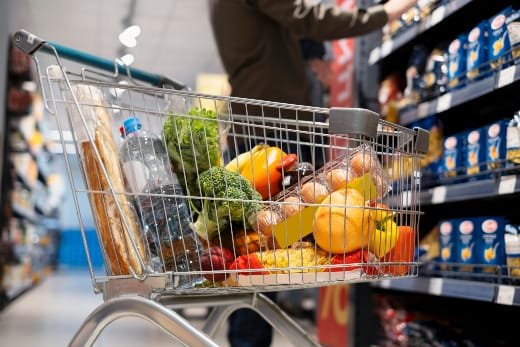Key Takeaways
- Grocery prices remain historically high globally despite falling commodity costs.
- Households are turning to strategic planning and DIY solutions to cope.
- Retailers are investing in waste reduction and supply chain efficiency.
- Mental health concerns and food insecurity are rising.
- Policymakers face calls for coordinated international responses.
By mid-2025, grocery store aisles in cities from Minneapolis to Manila echo with a shared anxiety: sticker shock isn’t going away.
A simple shopping list—heavy cream, bread, eggs, cheese—now consumes twice the budget it did just four years ago. In Facebook groups and Reddit threads, families trade coping strategies: meal plans, DIY yogurt recipes, tips on vacuum sealing. “I used to make a spinach-artichoke dip for under $15,” one U.S. user posted. “Now it’s over $30. And I’m just supposed to accept this?”
The unease is more than anecdotal. Global food prices surged 20% year-over-year in 2024. In low-income nations, the jump was closer to 30%, according to UN data. These aren’t the peaks of pandemic-era panic; they’re the stubborn plateaus of a new economic order. And for millions, they’re untenable.
Prices Up, Patience Down
The grocery crunch is not just economic—it’s emotional. Households report skipping meals, reducing fresh produce, and turning to cheaper, processed calories. “We used to get strawberries. Now we get canned peaches—when they’re on sale,” said Sandra Mejia, a single mother in Phoenix.
Price spikes in staples like dairy, bread, and eggs have far outpaced headline inflation. In January 2023, food inflation topped 13.6%, a full five points above broader inflation metrics. That gap persists today, driven not just by commodities, but by what economists call “structural stickiness”: embedded costs in logistics, labor, and energy that resist rapid deflation.
“Even if wheat prices fall,” said Arvind Keshavan, a supply chain economist at the University of British Columbia, “the cost to get bread from farm to shelf is still inflated—fuel, refrigeration, packaging, labor. It’s systemic.”
From Pandemic to Polycrisis
COVID-19 shattered global food supply chains. Recovery was brief. Russia’s war in Ukraine disrupted grain exports and fertilizer flows. Climate extremes—droughts in Brazil, floods in Pakistan—battered harvests. Combined, these shocks created cascading scarcities, with costs passed to the checkout aisle.
More recently, geopolitical tensions have compounded the problem. U.S. tariffs on Mexican tomatoes, retaliatory levies on Canadian dairy, and currency devaluations in sub-Saharan Africa are distorting flows and elevating costs.
“Food inflation is no longer just about food,” said Dr. Alice Tan, senior analyst at the International Food Policy Research Institute. “It’s about climate, conflict, energy, and economic fragility.”
Insecurity Isn’t Evenly Shared
While consumers worldwide are tightening belts, the burden is not equal. In low-income countries, where food can consume over 50% of household budgets, price hikes are life-threatening.
A 10% rise in food prices increases moderate or severe food insecurity by 3.5% in these regions, according to the FAO. In May 2023, food inflation reached 30% in several African nations—despite falling global commodity prices.
“The market’s not working for the poor,” said Maimouna Bah, a community organizer in Guinea. “Even when the world says prices are down, ours are still up. We don’t see relief.”
Consumers Turn Survivalist
Facing this reality, many consumers are recalibrating daily life. The grocery list has become a strategic plan. Families are adopting old-fashioned frugality with modern tools.
Private-label brands now account for over 40% of grocery baskets in the U.S., according to Nielsen. Digital coupon usage is at a five-year high. Vacuum sealer sales are up 23% year-over-year. Even fermentation kits and butter churners are trending.
“It’s not just budgeting anymore. It’s food security,” said Rebecca Jansen, a Minneapolis mother of three. “We’re learning to make yogurt. Who would’ve thought?”
The Industry’s Response: Shrink, Source, Survive
Retailers aren’t ignoring the problem—but they’re navigating it with an eye on margins. Supply chain optimization is in vogue: streamlined logistics, localized sourcing, and investments in cold-chain technology aim to reduce cost and waste.
“Shrink”—industry shorthand for waste—is the new battleground. Supermarkets are using AI to predict spoilage, while manufacturers redesign packaging to extend shelf life. For retailers, it’s a dual win: cut costs, burnish ESG credentials.
Yet price relief has been elusive. “Efficiency gains take time to pass to shelf prices,” said Leah Bergstrom, an executive at a mid-sized grocery chain. “We’re stabilizing—but not deflating.”
Where Are the Policymakers?
Public policy has lagged behind the crisis. While central banks battle general inflation with rate hikes, food-specific interventions are limited and often reactive.
Some governments are rolling out direct food subsidies or capping staple prices, but these measures are politically fraught and fiscally unsustainable. Longer-term, economists call for investment in agricultural R&D, rural infrastructure, and resilient supply chains.
“There’s no silver bullet,” said Prof. Raj Patel, a food systems expert at the University of Texas. “But there is a toolkit—and it’s gathering dust in too many capitals.”
Permanent Crisis or New Normal?
A key concern among analysts is normalization. If high prices persist, they risk becoming structurally embedded—especially if consumers adapt, companies adjust, and policymakers delay.
That shift has serious consequences: entrenched food insecurity, degraded health outcomes, and weakened public trust. As wages stagnate and inequality grows, access to affordable, nutritious food may become the next great economic divider.
“Food is not just a commodity. It’s a right,” said Dr. Tan. “If we normalize its inaccessibility, we normalize systemic failure.”



